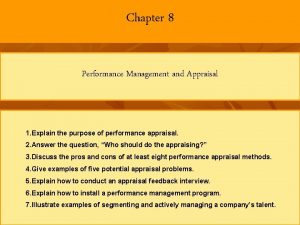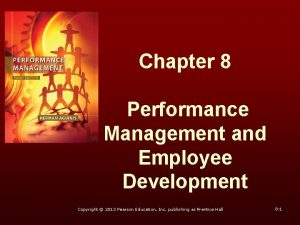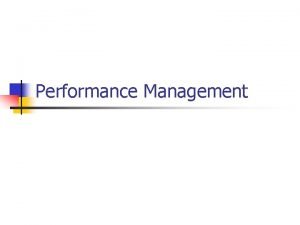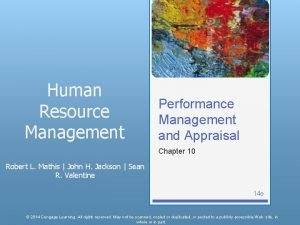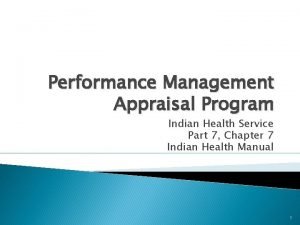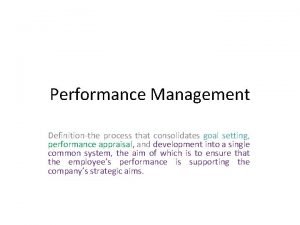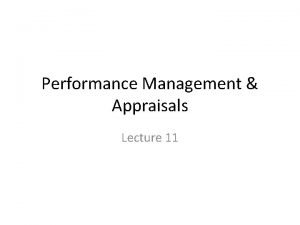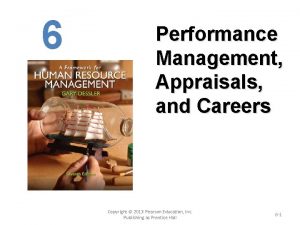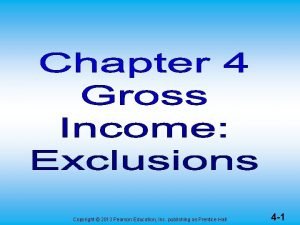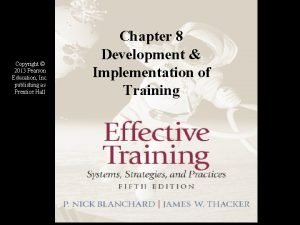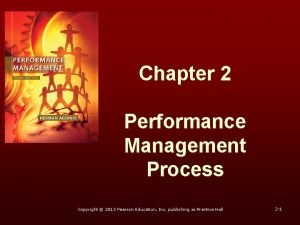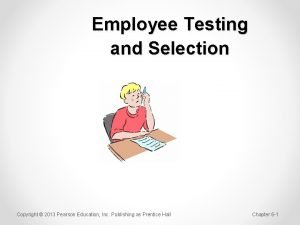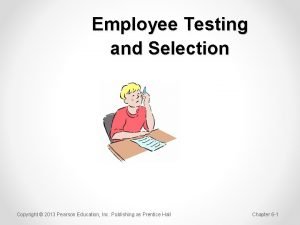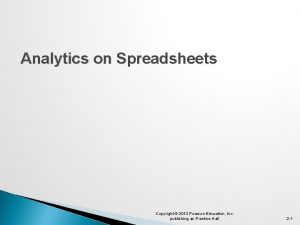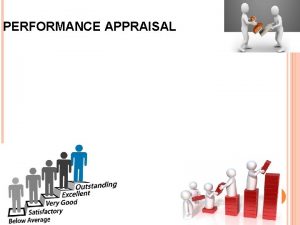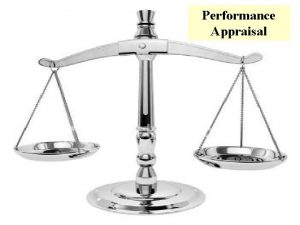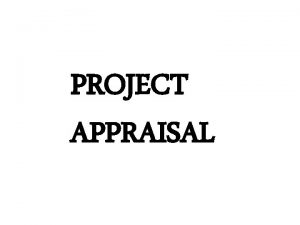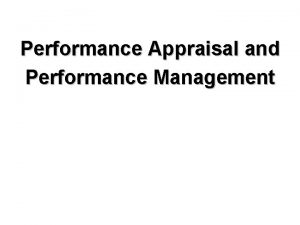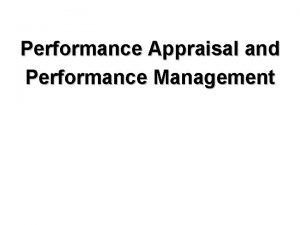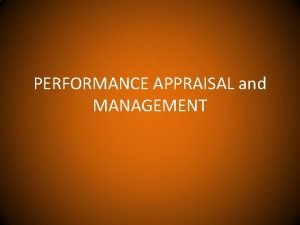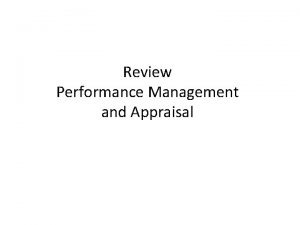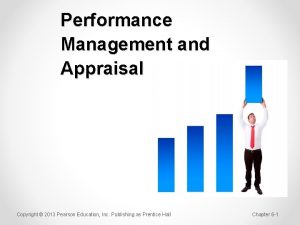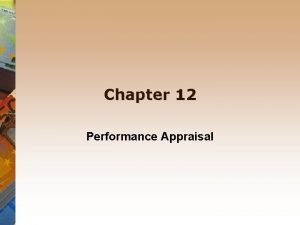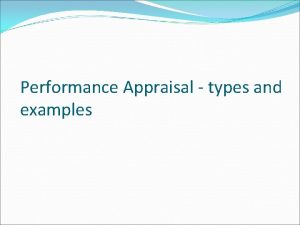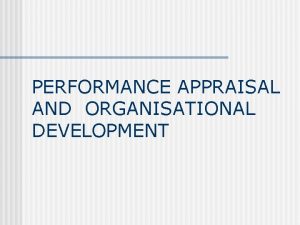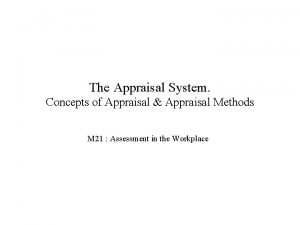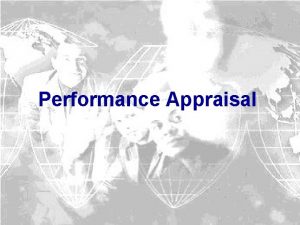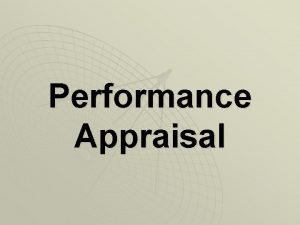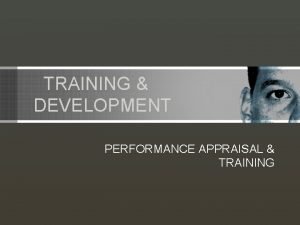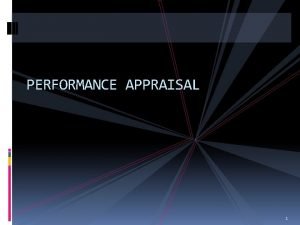9 Performance Management and Appraisal Copyright 2013 Pearson




































- Slides: 36

9 Performance Management and Appraisal Copyright © 2013 Pearson Education, Inc. Publishing as Prentice Hall Chapter 6 -1

Learning Objectives 1. Define performance management and discuss how it differs from performance appraisal. 2. Describe the appraisal process. 3. Set effective performance appraisal standards. Copyright © 2013 Pearson Education, Inc. Publishing as Prentice Hall Chapter 9 -2

Learning Objectives 4. Develop, evaluate, and administer at least four performance appraisal tools. 5. Explain and illustrate the problems to avoid in appraising performance. Copyright © 2013 Pearson Education, Inc. Publishing as Prentice Hall Chapter 9 -3

• Performance management has to do with creating an organizational system that is fair, effective, and widely understood by all. • The goal of the system is to support the strategic aims of the firm by establishing a valid and reliable process connecting the employees to it. Performance appraisal involves : (1) setting work standards, (2) assessing actual performance relative to those standards, and (3) providing feedback to the employee. Chapter 9 -4

Comparing Performance Appraisal and Performance Management • Performance appraisal o Evaluating an employee’s current and/or past performance relative to his or her performance standards. • Performance management o The process employers use to make sure employees are working toward organizational goals. 9– 5

Why Performance Management? • Increasing use by employers performance management reflects: of o The necessity in today’s globally competitive industrial environment for every employee’s efforts to focus on helping the company to achieve its strategic goals. 9– 6

An Introduction to Appraising Performance • Why appraise performance? o Appraisals play an integral role in the employer’s performance management process. o Appraisals help in planning for correcting deficiencies and reinforce things done correctly. o Appraisals, in identifying employee strengths weaknesses, are useful for career planning. and o Appraisals affect the employer’s salary raise decisions. 9– 7

The Performance Appraisal Process • Aligning the employee’s efforts with the job’s standards should be a continuous process. • When you see a performance problem, the time to take action is immediately. • Similarly, when someone does something well, the best reinforcement comes immediately, not six months later. Copyright © 2013 Pearson Education, Inc. Publishing as Prentice Hall Chapter 9 -8

Set effective performance appraisal standards. Copyright © 2013 Pearson Education, Inc. Publishing as Prentice Hall Chapter 9 -9

Employee’s Goals and Performance Standards • At the heart of performance management is the idea that employees’ efforts should be goal directed. Such a process involves clarifying expectations and quantifying them by setting measurable standards for each objective. Goals should be: 1. Specific 2. Measurable 3. Challenging but attainable 4. Relevant and timely 5. Finally, employees should always have the opportunity to have meaningful input into the goals they are to achieve. Copyright © 2013 Pearson Education, Inc. Publishing as Prentice Hall Chapter 9 -10

Employee’s Goals and Performance Standards • Competencies are often arranged according to the basic technical, motor, intellectual, and other skills needed to be successful in a job. In addition, the minimum level of each skill needed should be specified. • Ideally, what to appraise and how to appraise it will be obvious from the job description. For the criteria to appraise, the job description should list the job’s duties or tasks, including how critical each is to the job and how often it’s performed. Copyright © 2013 Pearson Education, Inc. Publishing as Prentice Hall Chapter 9 -11

Who Should Do the Appraising? • • • Immediate supervisor Peer appraisals Rating committees Self-ratings Appraisal by subordinates 360 -degree feedback Copyright © 2013 Pearson Education, Inc. Publishing as Prentice Hall Chapter 9 -12

Techniques for Appraising Performance • The graphic rating scale method is the simplest and most popular performance appraisal technique. First, a scale is used to list a number of traits and a range of performance for each. Then the employee is rated by identifying the score that best describes his/her performance level for each trait. • Managers must decide which job performance aspects to measure. Such aspects include generic dimensions, actual job duties, or behaviorally recognizable competencies. Copyright © 2013 Pearson Education, Inc. Publishing as Prentice Hall Chapter 9 -13

Graphic Rating Scale with Space for Comments Figure 9– 3 9– 14

Source: www. cwru. edu. 9– 15 Figure 9– 5 a

Performance Appraisal Methods (cont’d) • Alternation ranking method o Ranking employees from best to worst on a particular trait, choosing highest, then lowest, until all are ranked. • Paired comparison method o Ranking employees by making a chart of all possible pairs of the employees for each trait and indicating which is the better employee of the pair. 9– 16

Alternation Ranking Scale Figure 9– 6 9– 17

Ranking Employees by the Paired Comparison Method Note: + means “better than. ” − means “worse than. ” For each chart, add up the number of 1’s in each column to get the highest-ranked employee. Figure 9– 7

Performance Appraisal Methods (cont’d) • Forced distribution method o Similar to grading on a curve; predetermined percentages of ratees are placed in various performance categories. o Example: • • • 15% high performers 20% high-average performers 30% average performers 20% low-average performers 15% low performers

Performance Appraisal Methods (cont’d) • Behaviorally (BARS) anchored rating scale o An appraisal method that uses quantified scale with specific narrative examples of good and poor performance. • Developing a BARS: o Generate critical incidents o Develop performance dimensions o Reallocate incidents o Scale the incidents o Develop a final instrument 9– 20

Examples of Critical Incidents for an Assistant Plant Manager Table 9– 1 9– 21

Example of a Behaviorally Anchored Rating Scale for the Dimension Salesmanship Skill Source: Walter C. Borman, “Behavior Based Rating, ” in Ronald A. Berk (ed. ), Performance Assessment: Methods and Applications (Baltimore, MD: Johns Hopkins University Press, 1986), p. 103. Figure 9– 9

Management by Objectives (MBO) • Involves setting specific measurable goals with each employee and then periodically reviewing the progress made. 1. 2. 3. 4. 5. 6. Set the organization’s goals. Set departmental goals. Discuss departmental goals. Define expected results (set individual goals). Performance reviews. Provide feedback.

Computerized and Web-Based Performance Appraisal • Performance appraisal software programs o Keep notes on subordinates during the year. o Electronically rate employees on a series of performance traits. o Generate written text to support each part of the appraisal. • Electronic performance monitoring (EPM) o Having supervisors electronically monitor the amount of computerized data an employee is processing per day, and thereby his or her performance. 9– 24

Advantages and Disadvantages of Appraisal Tools Table 9– 3 9– 25

Potential Rating Scale Appraisal Problems • Unclear standards o An appraisal that is too open to interpretation. • Halo effect o Occurs when a supervisor’s rating of a subordinate on one trait biases the rating of that person on other traits. • Central tendency o A tendency to rate all employees the same way, such as rating them all average.

A Graphic Rating Scale with Unclear Standards Note: For example, what exactly is meant by “good, ” “quantity of work, ” and so forth? Table 9– 27

Potential Rating Scale Appraisal Problems (cont’d) • Strictness/leniency o The problem that occurs when a supervisor has a tendency to rate all subordinates either high or low. • Bias o The tendency to allow individual differences such as age, race, and sex to affect the appraisal ratings employees receive. 9– 28

How to Avoid Appraisal Problems • Learn and understand the potential problems, and the solutions for each. • Use the right appraisal tool. Each tool has its own pros and cons. • Train supervisors to reduce rating errors such as halo, leniency, and central tendency. • Have raters compile positive and negative critical incidents as they occur.

Guidelines for Effective Appraisals • • • Know the problems Use the right tool Keep a diary Get agreement on a plan Ensure fairness Appraisals and the law Copyright © 2013 Pearson Education, Inc. Publishing as Prentice Hall Chapter 9 -30

Perform an effective appraisal interview. Copyright © 2013 Pearson Education, Inc. Publishing as Prentice Hall Chapter 9 -31

The Appraisal Interview • Types of appraisal interviews o Satisfactory—Promotable: This is the easiest interview, the objective is to make development plans. o Satisfactory—Not promotable: This type of interview has the objective of maintaining performance when promotion is not possible. o Unsatisfactory—Correctable: This has the objective to plan correction via the development and successful implementation of an action plan. o Unsatisfactory—Uncorrectable

Managing the Appraisal Interview • How to conduct the appraisal interview o Objective data o Don’t get personal o Encouragement o Agreement Copyright © 2013 Pearson Education, Inc. Publishing as Prentice Hall Chapter 9 -33

The Appraisal Interview (cont’d) • How to handle a defensive subordinate o Recognize that defensive behavior is normal. o Never attack a person’s defenses. o Postpone action. o Recognize your own limitations. 9– 34

The Appraisal Interview (cont’d) • How to criticize a subordinate o Do it in a manner that lets the person maintain his or her dignity and sense of worth. o Criticize in private, and do it constructively. o Avoid once-a-year “critical broadsides” by giving feedback on a daily basis, so that the formal review contains no surprises. o Never say the person is “always” wrong o Criticism should be objective and free of any personal biases on your part. 9– 35

The Appraisal Interview (cont’d) • How to ensure the interview leads to improved performance o Don’t make the subordinate feel threatened during the interview. o Give the subordinate the opportunity to present his or her ideas and feelings and to influence the course of the interview. o Have a helpful and constructive supervisor conduct the interview. o Offer the subordinate the necessary support for development and change. 9– 36
 Performance management vs performance appraisal
Performance management vs performance appraisal Performance management vs performance appraisal
Performance management vs performance appraisal Chapter 8 performance management and appraisal
Chapter 8 performance management and appraisal Performance management and appraisal chapter 8
Performance management and appraisal chapter 8 Employee development
Employee development Important of performance appraisal
Important of performance appraisal Mbo performance appraisal method
Mbo performance appraisal method Management fifteenth edition
Management fifteenth edition Performance management appraisal program
Performance management appraisal program Copyright 2013
Copyright 2013 Mbo performance appraisal method
Mbo performance appraisal method Unclear standards in performance appraisal
Unclear standards in performance appraisal Appraisal interview
Appraisal interview Halo and horn effect in performance appraisal
Halo and horn effect in performance appraisal Computerized and web-based performance appraisal
Computerized and web-based performance appraisal 2013 pearson education inc
2013 pearson education inc 2013 pearson education inc
2013 pearson education inc Performance gap
Performance gap 2013 pearson education inc
2013 pearson education inc 2013 pearson education inc
2013 pearson education inc 2013 pearson education inc
2013 pearson education inc 2013 pearson education inc
2013 pearson education inc 2013 pearson education inc
2013 pearson education inc 2013 pearson education inc
2013 pearson education inc Are clusters of measurable ksas
Are clusters of measurable ksas 2013 pearson education inc. answers
2013 pearson education inc. answers Employee testing and selection
Employee testing and selection 2013 pearson education inc
2013 pearson education inc 2013 pearson education inc
2013 pearson education inc Pearson education limited 2017
Pearson education limited 2017 2017 pearson education inc
2017 pearson education inc Copyright 2010 pearson education inc
Copyright 2010 pearson education inc Copyright 2009 pearson education inc
Copyright 2009 pearson education inc 2018 pearson education inc
2018 pearson education inc 2014 pearson education inc
2014 pearson education inc Copyright 2010 pearson education inc
Copyright 2010 pearson education inc Copyright 2010 pearson education inc
Copyright 2010 pearson education inc


